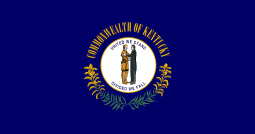Kentucky Democratic Party
The Kentucky Democratic Party is the affiliate of the Democratic Party in the Commonwealth of Kentucky. The party is a longstanding institution in the Commonwealth; 50.5% of Kentuckians are currently registered as Democrats.[1]
Kentucky Democratic Party | |
|---|---|
 Kentucky Democrats Logo | |
| Chairperson | Ben Self |
| Governor of Kentucky | Andy Beshear |
| Lieutenant Governor of Kentucky | Jacqueline Coleman |
| Senate Minority Leader | Morgan McGarvey |
| House Minority Leader | Joni Jenkins |
| Headquarters | Frankfort, KY |
| Ideology | Liberalism Centrism Social liberalism |
| Political position | Center to center-left |
| National affiliation | Democratic Party |
| Colors | Blue |
| Statewide Executive Offices | 2 / 7
|
| Senate | 10 / 38
|
| House of Representatives | 37 / 100
|
| U.S. Senate | 0 / 2
|
| U.S. House of Representatives | 1 / 6
|
| Website | |
| https://kydemocrats.org | |
Following the 2016 elections, Democrats lost majority status in the Kentucky House of Representatives for the first time in several decades. As of the 2019 statewide elections, the only executive offices the party holds are the Governor's and Lieutenant Governor's offices.
Party by-laws
The structure of the Kentucky Democratic Party states that the power rests in the hands of the members and is to be conducted in accordance with the Constitutions of the United States and the Commonwealth of Kentucky. A member is anyone who is registered as a Democrat in the Commonwealth of Kentucky, and states that no discrimination will take part in anyone wishing to join the party.
Governing of the Kentucky Democratic Party articulates that proxy votes are not permitted and unit rules are forbidden. The organization aims to take strong stances against forcing members to vote a certain way, but instead endorses all candidates which meet their ideological structure most effectively.
The functions of the State Party are orchestrated by the State Central Executive Committee, County Executive Committees, and Precinct Committees. The members of each committee are nominated and elected at their respective conventions during a party-wide reorganization from the precinct level up which begins in April of every Presidential election year. Members of each precinct must select one man, one woman, and one youth to represent their precinct. One member is then selected as the Precinct Chair. Those elected to their Precinct Committee then meet for the County Convention wherein they elect 10 men and 10 women to serve on as members of the County Executive Committee, who in turn elect a Chair and Vice Chair. Also at the County Convention, certain members will be nominated to represent the county at the Kentucky Democratic Convention to elect new members to the State Central Executive Committee as well as delegates to the Democratic National Convention.[2]

History
Kentucky politics has been relatively evenly matched between Democrats and Republicans. There has been no Democratic President from Kentucky, but there have been three Democratic Vice Presidents from the state. The first Vice President from Kentucky, Richard M. Johnson, was the ninth Vice President of the United States. In the earliest part of the 19th century Johnson was a supporter of the Democratic-Republican Party during his service in the U.S. House, Johnson would work to secure pensions for widows and orphans of wars, in particular those following the War of 1812, a stance that would set precedence for future Kentucky Democrats.[3] Johnson would later become a strong supporter and influence in the Democratic Party along with his service in the White House from 1837 to 1840.[4]
John C. Breckinridge served as the 14th Vice President (1857–1861) and a notable figure in the early Democratic Party of Kentucky, although Breckinridge claimed himself not an anti-union demonstrator, during the civil war, yet strongly supported the states right to determine slavery and would go on to be an officer in the confederate army.[5]
Alben W. Barkley Vice President (1949–1953) began his Kentucky Democratic influence as a county Judge, and would become a U.S. House of Representatives and go onto the U.S. Senate with strong ties to Woodrow Wilson's liberal agenda, as well as during Franklin D Roosevelt's Administration, and would help transition Kentucky's Democratic Party into the modern era of politics.[6]
Since the 20th century and early part of the 21st century, Democrats have largely dominated the office of governor in the State of Kentucky; out of 26 governors since 1900, only seven have not conducted office within the Democratic Party.[7]
Current elected officials
Members of Congress
U.S. Senate
- None
Both of Kentucky's U.S. Senate seats have been held by Republicans since 1998. Wendell Ford was the last Democrat to represent Kentucky in the U.S. Senate. First elected in 1974, Ford opted to retire instead of seeking a fifth term. Congressman Scotty Baesler ran as the Democratic nominee in the 1998 election and was subsequently defeated by Republican challenger Jim Bunning.
U.S. House of Representatives
Out of the 6 seats Kentucky is apportioned in the U.S. House of Representatives, 1 is held by a Democrat:
Statewide offices
Democrats control two of the seven elected statewide offices:
State legislative leaders
Kentucky General Assembly
House of Representatives
In the House of Representatives, Democrats hold a minority of seats. The Democratic Party in the House is led by the Minority Floor Leader Rocky Adkins; Minority Caucus Chairman is Dennis Keene and Minority Whip is Wilson Stone.[10]
Senate
In the Senate, Democrats hold a minority of seats. Leading figures of the Democratic Party in the Senate include Minority Floor Leader Ray S. Jones II, Minority Caucus Chairman Dorsey Ridley, and Minority Whip Dennis Parrett.[11]
Ideology
Health care
The Democratic Party has been supportive of mild healthcare reform since the turn of the 20th century.[12] The Democratic Party of Kentucky supports the Affordable Care Act, President Barack Obama's health care reform that took effect in 2014. Under the act, health care providers will no longer be able to refuse coverage to anyone based on their past medical experience.
In 2006, 2,000,231 people between the ages of 25 and 64 were living in Kentucky, of those an estimated 19 percent were living without health insurance.[13] Almost every company that provides health care coverage in Kentucky has the right to refuse coverage. Over the decade 2000–2009 family health insurance premiums rose 3.3 times faster than median earnings. Under the new reforms, insurance companies will no longer be able to discriminate against those with pre-existing conditions. By 2019, an estimated 438,000 Kentuckians will gain coverage.[14]
Infrastructure
The Kentucky Infrastructure Authority was founded in 1988 to develop and fund a better infrastructure for the state. Its main reason for existence has been to finance local development and works as an office under the Governor.[15]
In 2009, the Kentucky Infrastructure Authority distributed 47.8 million dollars to fund wastewater infrastructure projects. An additional 18.9 million dollars was made available to improve funding for drinking water projects in the state. The funding was to be distributed through the Clean Water State Revolving Fund and the Drinking Water State Revolving Fund, which were directly funded by the American Recovery and Reinvestment Act of 2009, which was strongly supported by Democrats and implemented by President Obama. Governor Beshear, a strong supporter of President Obama's Reinvestment Act, stated that these infrastructure improvements will not only create jobs but address short and long-term water challenges for the state of Kentucky.[16]
See also
References
- http://elect.ky.gov/statistics/Documents/voterstatscounty-20170718-084631.pdf
- "Our Bylaws." Kentucky Democratic Party. Web. 26 September 2017
- "American President: Richard M. Johnson (1837–1841)." Miller Center. Web. 28 November 2011. <http://millercenter.org/president/vanburen/essays/vicepresident/1862 Archived 2011-10-15 at the Wayback Machine>
- "Richard M. Johnson (vice President of United States) -- Britannica Online Encyclopedia." Encyclopedia - Britannica Online Encyclopedia. Web. 28 November 2011. <http://www.britannica.com/EBchecked/topic/305425/Richard-M-Johnson>
- "John C. Breckinridge (vice President of United States) -- Britannica Online Encyclopedia." Encyclopedia - Britannica Online Encyclopedia. Web. 28 November 2011. <http://www.britannica.com/EBchecked/topic/78636/John-C-Breckinridge>
- "American President: Alben W. Barkley." Miller Center. Web. 29 November 2011. <http://millercenter.org/president/truman/essays/vicepresident/1836 Archived 2011-10-15 at the Wayback Machine>
- "The US50 - A Guide to the State of Kentucky - List of Governors." The US50 - A Guide to the Fifty States. Web. 29 November 2011. <http://www.theus50.com/kentucky/governors.php>
- "His online work helped elect Obama. Can he rebuild Kentucky's Democratic Party? | Lexington Herald-Leader". kentucky.com/. Retrieved 2018-03-27.
- "Cassie Chambers elected new vice chair of the Kentucky Democratic Party | Medium – @BradBowman". https://medium.com. Retrieved 2018-03-27. External link in
|website=(help) - "House Leadership." Kentucky Legislature Home Page. Web. 06 January 2017. <http://www.lrc.ky.gov/House.htm>.
- "Senate Leadership." Kentucky Legislature Home Page. Web. 24 September 2017. <http://www.lrc.ky.gov/Senate.htm>.
- "What We Stand For: Health Care." Democrats.org. Democratic National Committee. Web. 3 November 2011. <http://www.democrats.org/issues/health_care Archived 2014-05-30 at the Wayback Machine>
- Wikler, Beth, and Kim Bailey. "Dying For Coverage In Kentucky." Families USA: The Voice for Health Care Consumers. April 2008. Web. 30 October 2011. <http://www.familiesusa.org/>
- McAndrew, Claire. "Health Coverage in Kentucky: How Will Health Reform Help?" Families USA (2010). Print
- "Welcome." Kentucky: Infrastructure Authority - Home. Kentucky Infrastructure Authority. Web. 11 December 2011. <http://kia.ky.gov/>
- "Kentucky: Infrastructure Authority - Recovery Act Investments Announced for Kentucky's Infrastructure." Kentucky: Infrastructure Authority - Home. 1 May 2009. Web. 11 December 2011. <http://kia.ky.gov/news/ARRAprioritylists.htm>
